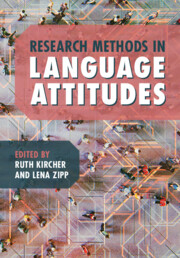Book contents
- Research Methods in Language Attitudes
- Research Methods in Language Attitudes
- Copyright page
- Contents
- Figures
- Tables
- Contributors
- Foreword
- Acknowledgements
- 1 An Introduction to Language Attitudes Research
- Part 1 Analysis of the Societal Treatment of Language
- Part 2 Direct Methods of Attitude Elicitation
- Part 3 Indirect Methods of Attitude Elicitation
- 12 The Matched-Guise Technique
- 13 The Verbal-Guise Technique
- 14 The Theatre-Audience Method
- 15 Experimental Methods to Elicit Language Attitudes among Children
- 16 The Implicit Association Test Paradigm
- Part 4 Overarching Issues in Language Attitudes Research
- References
- Index
- References
16 - The Implicit Association Test Paradigm
from Part 3 - Indirect Methods of Attitude Elicitation
Published online by Cambridge University Press: 25 June 2022
- Research Methods in Language Attitudes
- Research Methods in Language Attitudes
- Copyright page
- Contents
- Figures
- Tables
- Contributors
- Foreword
- Acknowledgements
- 1 An Introduction to Language Attitudes Research
- Part 1 Analysis of the Societal Treatment of Language
- Part 2 Direct Methods of Attitude Elicitation
- Part 3 Indirect Methods of Attitude Elicitation
- 12 The Matched-Guise Technique
- 13 The Verbal-Guise Technique
- 14 The Theatre-Audience Method
- 15 Experimental Methods to Elicit Language Attitudes among Children
- 16 The Implicit Association Test Paradigm
- Part 4 Overarching Issues in Language Attitudes Research
- References
- Index
- References
Summary
This chapter discusses the Implicit Association Test (IAT) and its variants as novel measures for implicit language attitudes. The IAT is a reaction time-based categorisation task that measures automatic associations between a target and attribute concept. In the case of language attitudes, this comes down to measuring whether people automatically associate a language (variety) or linguistic feature with positive/negative valence or with specific social attributes of the speaker. The method originates in social psychology, where it has been used to study a wide variety of topics (e.g. racial bias, self-esteem), and has recently been introduced to linguistics to study the social meaning of language variation. This chapter discusses the merits and potential disadvantages of using the IAT paradigm for such linguistic purposes. In addition, the chapter gives a practical introduction to setting up a study using the IAT paradigm and explains how to analyse the reaction time data harvested in the experiment and interpret the results. The main points of the chapter are illustrated with a case study that uses the P-IAT to measure associations with Standard Belgian Dutch as well as two regional varieties of Belgian Dutch.
Keywords
Information
- Type
- Chapter
- Information
- Research Methods in Language Attitudes , pp. 250 - 268Publisher: Cambridge University PressPrint publication year: 2022
References
Suggested further readings
Accessibility standard: Unknown
Why this information is here
This section outlines the accessibility features of this content - including support for screen readers, full keyboard navigation and high-contrast display options. This may not be relevant for you.Accessibility Information
- 2
- Cited by
